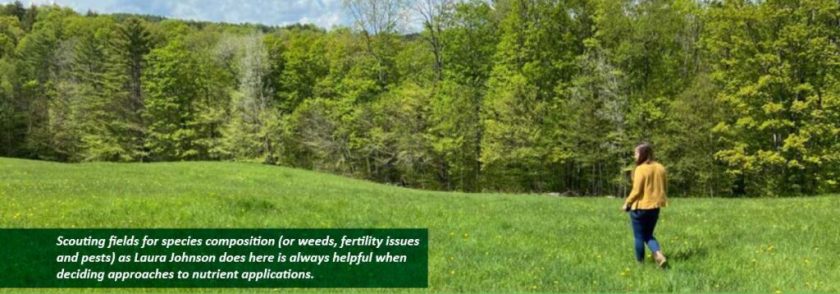This article is part of our Summer 2021 Newsletter by Kirsten Workman.

Perennial crops can be hard to target for nitrogen (N) applications, as the decision often depends on stage of establishment and species composition. Both factors change over time and adjustments should be made from season to season, or even within the same season. Below are factors to consider when trying to target the most efficient use of manure-based and purchased nitrogen in your perennial crops.
Species
Grass and legumes (alfalfa, clovers, trefoil) each have very different nitrogen needs. Grass crops will respond readily to both manure-based and fertilizer-based nitrogen. Grass species not only reward adequate N supply with increased yield, but also increased quality. Applying up to (and sometimes over) 200 pounds of nitrogen per acre on grasses almost always yields an economically viable response. Legumes, on the other hand, do not need additional nitrogen from manure or fertilizer. Legumes have a fascinating symbiotic relationship with a soil-borne bacteria known as rhizobia. Rhizobia fixes atmospheric nitrogen in nodules on the roots that it colonizes, and then transforms it into plant-available nitrogen. As a result, a clear stand of clover or alfalfa would not need additional nitrogen fertilizer or manure to reach maximum yield or quality. However, very few hay or pasture stands in Vermont are 100% grass or legume, and most farmers want a combination to maximize the benefits of species diversity and production. In these cases, we adjust the recommended nitrogen application rate to maximize production but still encourage the legumes in the stand to fix nitrogen. Fixing nitrogen is a trade-off for the plant, which shares carbohydrates with the rhizobia. This means that if extra nitrogen is available, plants can become “lazy” and not invest energy in that association. Additionally, a mixed stand with legumes that is treated with N up to the grass rates will encourage a shift of dominant species towards grasses as the grasses begin to outcompete the legumes.The table below shows how the nitrogen recommendations change depending on the legume content of the stand. In this case, grass is defined as any stand with less than 30% legume.
Split Applications
Because N is mobile (both in the soil and the plant), it is important to split applications to maximize uptake by the plant and reduce losses. With hay and pasture, fortunately, we take multiple harvests and have the opportunity to split applications into reasonable amounts to be utilized by the crop over the course of the season:
• Grass: split applications into 50 to 75 pounds per acre increments, ideally following each harvest.
• Mixed stands (30-60% legume): one single 40-pound application; if applied in early spring, a second 40-pound application may be beneficial.
N During Establishment (New Seedings)
Nitrogen fertility is not recommended for establishing legumes and mixtures. The exception is when a small grain is seeded with the legume or mixture. In this case, a 30 pound per acre application is recommended to get the companion crop up and growing ahead of the weeds. For a new grass seeding, the following recommendations apply:
• 50 pounds per acre for a spring seeded crop.
• If more than one harvest occurs in the seeding year, a second application of 40 to 50 pounds should be applied.
• Late summer seedings only need 30 pounds per acre.
Reducing Needed N With Maintenance of Legumes
If nutrients are limited and you are trying to reserve manure-based nitrogen for crops like corn or pure grass, take steps to maintain legumes in your stand. This will reduce or eliminate the need for manure or purchased nitrogen. Strategies to help maintain legumes include:
Maintain higher soil pH (6.8).
• Leave adequate crop residual between cuttings, but especially after your last cutting.
• Consider a less intensive cutting schedule to ensure adequate regrowth between harvests. Time your last harvest to allow for adequate regrowth before frost.
• Monitor and maintain adequate potassium and boron levels in the soil.
At the end of the day, managing nitrogen resources on hay and pasture crops will pay off. A well-fertilized grass crop will pay you back in most years. However, manure is especially tricky, as it is easy to overapply N on mixed stands and this can contribute to legumes becoming less competitive, leaving the stand open to weeds. If you want to maintain legumes, back off on N and manage for legumes. Split applications for the best effect and, if possible, utilize low disturbance injection to really make the most of N in manure applications.
Making nutrient management decisions systematically on your farm and keeping good records is all part of having a nutrient management plan. Even without a formal plan, you can make informed decisions based on these basic principles. We are here to help farmers optimize yields and manage their inputs wisely.


*All recommendations are from “Nutrient Recommendations for Field Crops in Vermont” (September 2020, https://go.uvm.edu/br1390). For specific recommendations, consult your crop adviser or call Kirsten for more information. If you would like help managing nutrient application rates, or have other related nitrogen questions, contact Kirsten at kirsten.workman@uvm.edu or 802-338-4969 ext. 347.


